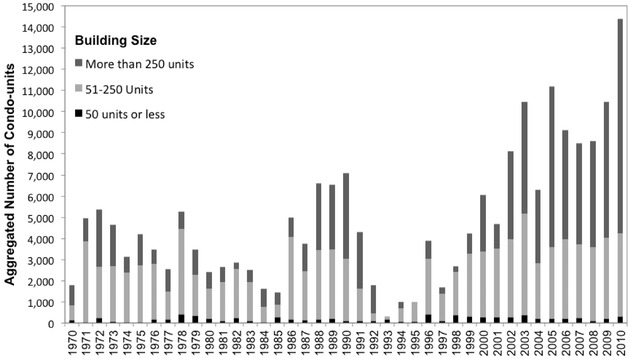 Thursday, September 19, 2024
Thursday, September 19, 2024  Thursday, September 19, 2024
Thursday, September 19, 2024 
This is a synopsis of the seventh of 10 Chapters, each to appear in Construction Links Network which began in November 2023. BUILDING TORONTO’s SKYLINE: TORONTO’S CONDOMINIUMS THROUGH THE AGES is available through Amazon in print, Kindle and audible editions.
If you consider the evolution of condominiums across North America over the years, Toronto was far from a leader for a long time. During the 1950s, single-family homes dominated the residential scene, especially in 1954 when mortgage loan insurance was established by CMHC. After the Second World War, housing was in great demand by Baby Boomers and European immigrants. Multi-family homes were less expensive, so those were in demand as well. Toward the end of the 60s, the price of single-family homes began to skyrocket, and in an attempt to provide more affordable housing, Ontario legalized condominiums. Forward-thinking developers constructed condominiums, starting a trend that continues to this day.

Early in the 1970s, complaints about poor construction and an oversupply of units began to surface. Condos quickly gained a reputation for being boring and unattractive. Mid-decade, sales collapsed. In addition, there was a backlash about high-rise development in Toronto, and Mayor David Crombie and his council enacted a two-year moratorium on new high-rise structures downtown. Ironically, individuals were better off when it comes to personal income, but inflation cut into that benefit. By the end of the decade, the city was into boom times again, and new luxurious condos began to pop up. Between 1974 and 1982, the proportion of newly built single- and multi-family homes was equal.
The rent controls of 1975 stopped the construction of new apartment buildings. Condos were an option, but most Toronto residents could not afford them. When mortgage rates peaked in the 1981-81 recession, residential construction decreased. When mortgage lending rates dipped, more people could afford single-family homes, so those became the in-demand form of housing.

The removal of rent controls for buildings constructed after 1991 resulted in a change in the situation, along with provincial laws and court decisions helped condo development along. Investors began buying up the city’s high-end apartments. Developers built condos at Harbourfront higher than promised, which sparked controversy. Toronto’s real estate bubble burst in 1989, and then we had another, this time deeper, recession. The city was rife with unsold condos but no interested buyers.
By 1997, condos were on the rise again, often in new areas of the city. We saw the advent of repurposed factories marketed as lofts and even new condos designed to look like lofts. Ever-changing demographics included baby boomers retiring and seeking maintenance-free living, and well as young people adopting an urban lifestyle to get away from time- an gas-consuming vehicle commuting.
The author of Building Toronto’s Skyline: Toronto Condominiums Through the Decades, Nick Ainis is Founder & CEO of Fusioncorp Developments, a boutique construction management company and general contracting organization specializing in multi-unit residential condominiums. Nick is an experienced and highly respected construction professional with a Bachelor of Technology degree in Architectural Science and Project Management from Ryerson University. With over 20 years of experience in the industry, he has a strong track record of delivering high-quality construction projects on time and within budget. Nick has expertise in managing high-rise residential projects and has developed a reputation as one of the industry’s finest project managers. As CEO of Fusioncorp, he is deeply involved in all aspects of each project from pre-construction through to construction and project closeout.
Check out more news, articles and blogs here